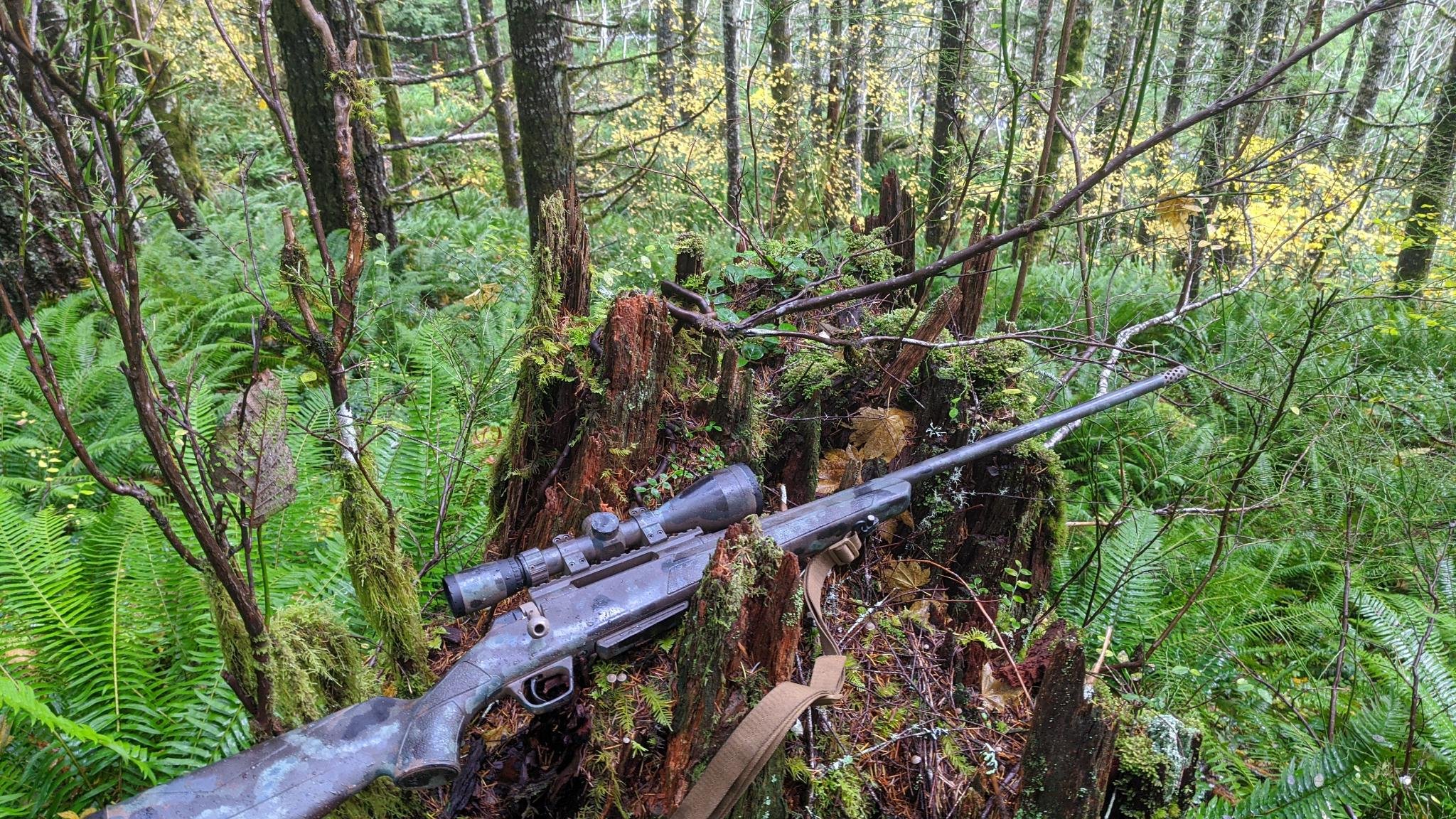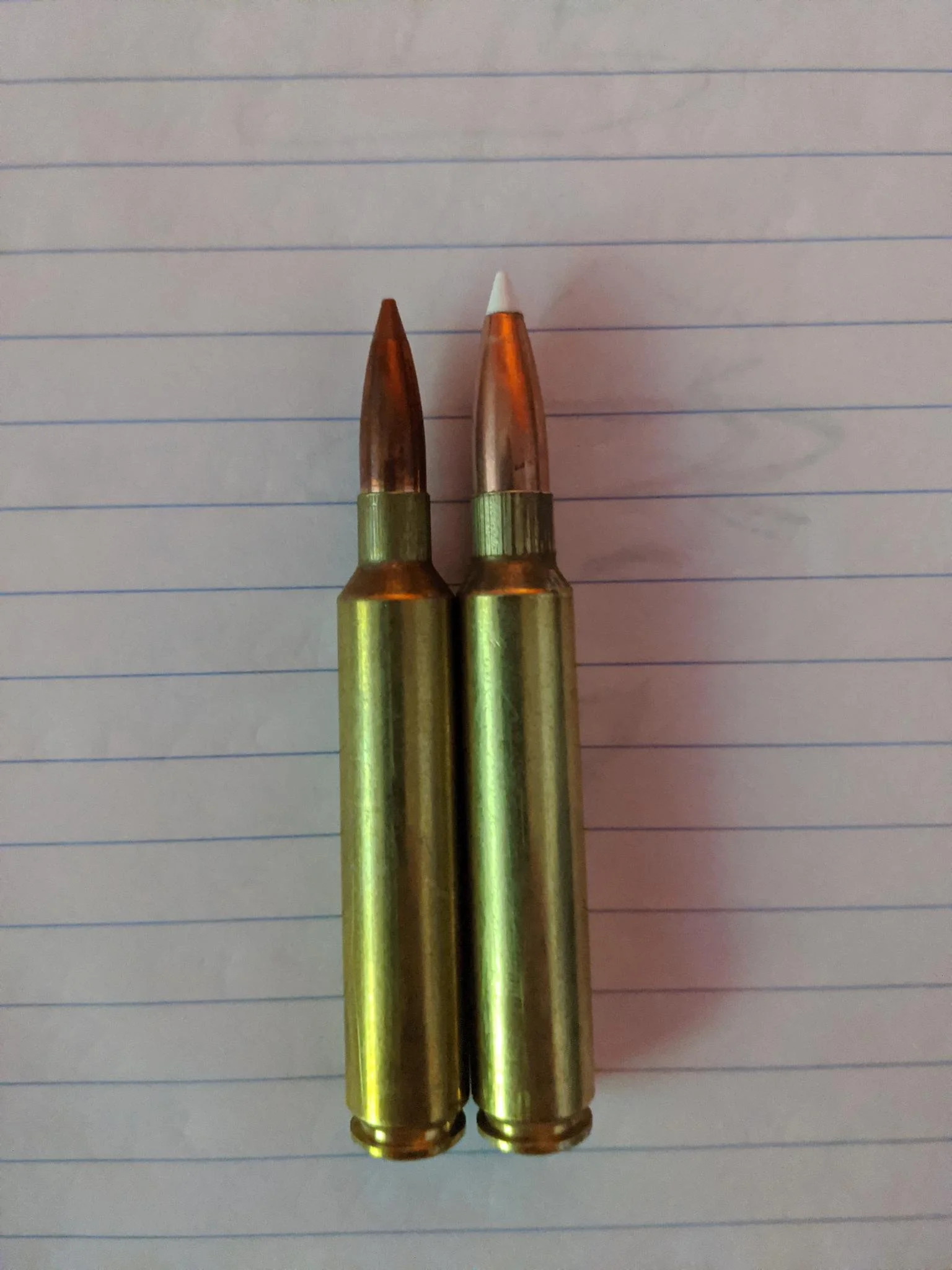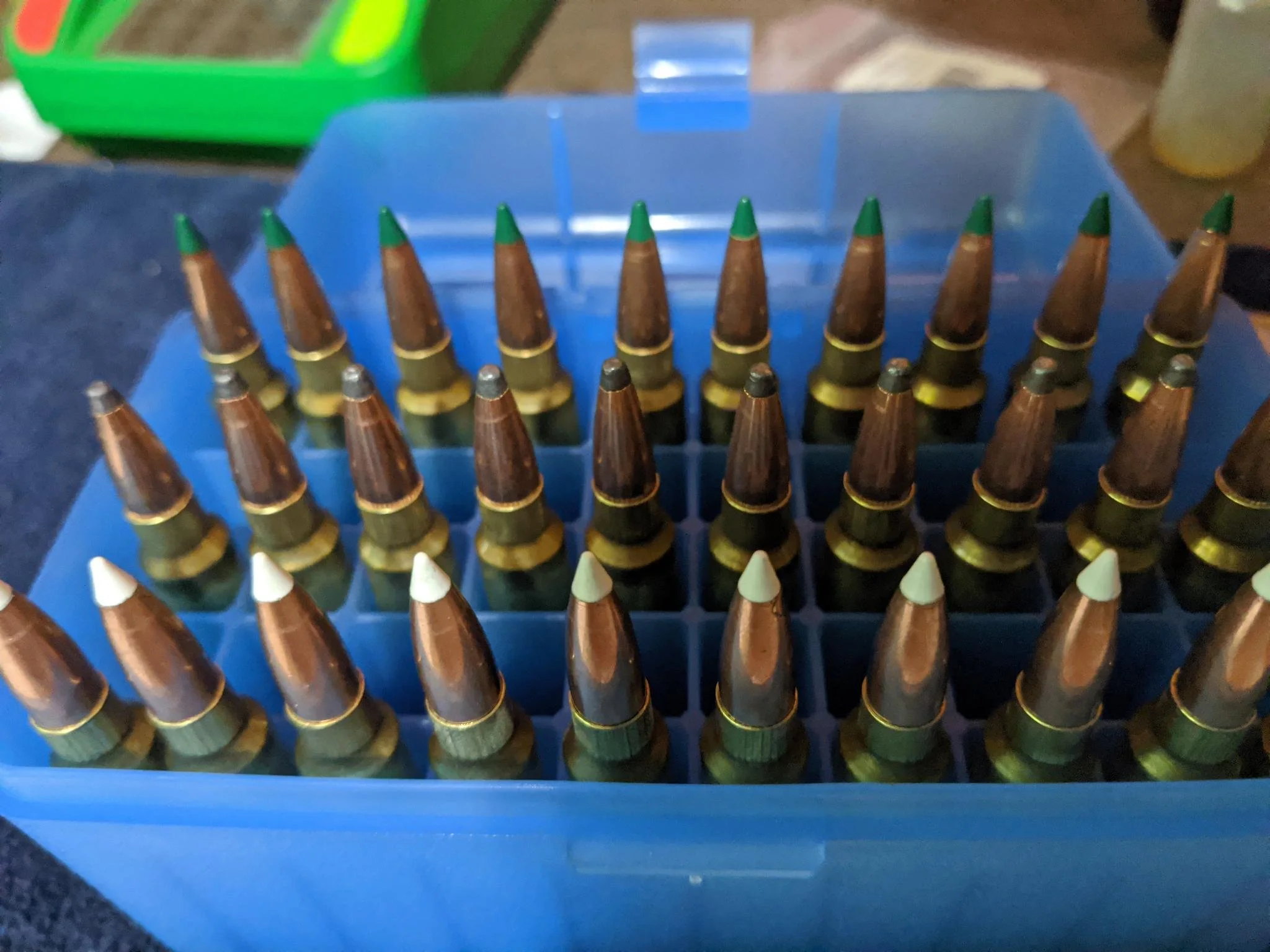.300 Karcher - A 6.5 Weatherby RPM Wildcat
This is the rifle that was converted from .30-06 to .300 Karcher, a .30-6.5 RPM with a long free bore that matches that of the .300 Weatherby Magnum. It’s topped with a Leupold VX Freedom 3-9×50, mounted with Warne rings and a Talley base. This picture was taken while deer hunting in Oregon.
Some time around 2010, an idea came to me; a wildcat cartridge based on a longer .284 Winchester case. To me, it seemed like the perfect balance between power, case dimensions, rifle weight, recoil, and barrel life. I wanted to make it .30 caliber, as I think the .30 is a perfect blend of bullet weight, sectional density, bore diameter and recoil. The case would be less capacity than the .300 Winchester Magnum and similar belted cases, but there would be no belt to contend with and any rifle capable of handling the upper end of pressure in modern cartridges could easily be converted. In essence, my idea was to make a slightly fatter .30-06 Springfield and my hope was that it would be somewhere close in power to the old .300 H&H magnum, yet fit in a standard length action. The problem was, I didn’t have the money to invest in making custom brass, and no big manufacturer made anything I could use in it’s place that was similar except the original short .284 case.
That is, until 2019, when Weatherby released the 6.5 Weatherby RPM ( Rebated Precision Magnum). Initially I passed it by, thinking it was “just another 6.5” when the craze for the 6.5 was in it’s peak. A few years later, Weatherby released the .338 RPM, and at that time I was interested in medium bores such as the .358 Winchester and .35 Whelen, the 338 Federal and A-Square cartridges, and similar. I had just replaced a shot-out barrel on a Howa 1500 in .25-06 with a McGowan Precision barrel chambered in .35 Whelen, and while it did what I expected it to do, I still never got the warm and fuzzies from it. It was then that I took notice of the .338 RPM cartridge, and by extension the 6.5 RPM. I was intrigued, but I ended up with a .375 H&H (later converted to .375 Weatherby) as I needed something for an upcoming dangerous game hunt in Africa, and decided I didn’t need another medium bore at the time.
Well, as fate would have it, just a few months before my hunt, I ended up burning the last of the life out of the barrel of my .300 Weatherby Magnum while dialing in a load to hunt plains game. I didn’t have the time to wait on a new barrel, and while I thought long and hard on taking the .35 Whelen, I never could get it to feed as well as I’d have liked with the aftermarket magazine and bottom metal (not to mention it wears a 24” McGowan No. 5 profile barrel, and weighs about 12 pounds unloaded). Enter the 6.5 RPM – I didn’t need or want to carry another medium bore for the plains game I was going to hunt, as I already had the .375 for the Cape Buffalo I was going after. I also thought long and hard on grabbing another .300 Weatherby off the rack at my local Sportsman’s Warehouse, but then a thought crept into my mind… what about that new 6.5 RPM? I never cared for the 6.5 caliber, having always favored the .277 and .284 bores for anything under .30 caliber, but the case design was exactly what I was looking for. While it wasn’t exactly what I wanted, I saw immense potential in the new cartridge. I quickly developed a load that duplicated the Weatherby factory ammo using a 140 grain Nosler Accubond, and then proceeded to hunt with it in South Africa in March of this year. Needless to say, I was impressed. The rifle was lightweight, hit hard, and nothing I shot with it needed a followup, and really only one animal ran more than 20 yards from where it stood when I shot it (an Impala, quartering slightly towards me, shot at about 110 yards ran about 80 yards away from where it was hit, and the bullet passed completely through from the front right just behind it’s shoulder and exited about midway down the body on the opposite side through the ribs.)
The afore-mentioned Impala, brought down with a 6.5 Weatherby RPM pushing a 140 grain Nosler Accubond.
The Weatherby cartridge was eye-opening, especially considering my initial disdain for anything 6.5 caliber. This is where my praise ends - as much as I liked the Mk V action it was chambered in, it also left a bit to be desired. The 6.5 was designed for the sole purpose of maximizing the power potential out of their six-lug Mk V action, and in that regard it can’t be beat, however, it also seemed to have the exact issue that the original .284 Winchester did back in the day of it’s conception, which is to say that the cartridge was just a touch too long to really maximize power it was capable of, specifically with the really heavy for caliber bullets. Around that time I was also looking at replacing my .300 Weatherby again. There are a ton of “Almost Magnum” wildcats based on the .30-06, like the Ackley Improved version, as well as the .30 Gibbs and .300 Sherman. In fact, I almost decided to try building either a Gibbs or Sherman wildcat, coupled with a .30-06 Serengeti throat, until I looked at a 6.5 RPM side by side next to one of my .35 Whelen cartridges, and that was when it finally fully clicked that it was time to finally build my original idea for a wildcat. Once again, the thought crossed my mind: What about the 6.5 RPM? After 24 years, I finally had my starting point for the wildcat.
My idea was simple: take an off the shelf .30-06 Springfield rifle (I didn’t own one at the time, nor do I have one now after the conversion) and cut a new chamber for the larger case. I had Manson make a chamber reamer for me for the necked up 6.5 case, as well as some headspace gauges, and off I went. I had already procured an allotment of the RPM brass, and already had a number of different .30 caliber projectiles to use to work up a load, and already had a decent stock of H4350 and magnum primers on hand, so the choice was easy to make.
The hard part was deciding on the appropriate rifle to use as the test bed. I wanted a detatchable magazine, was trying to keep the project relatively affordable, and wanted something with a long enough action to be able to seat the bullets our far enough to take advantage of the case’s powder capacity. In retrospect, I should have used the Remington 700 action as a starting point and just converted it to a bottom metal that would accept detachable magazines, but for the price point I was looking at my options were the Savage 110, Ruger American, Winchester XPR and Weatherby Vanguard. Of those, the XPR and Ruger were the options with factory detatchable magazines. In addition, I wanted a threaded barrel, and the only Ruger Americans I could find had shorter barrels than what I wanted. That left the XPR, and to top it off, Winchester had a rebate on them at the time.
Once the rifle was in hand, it was only a matter of waiting for my reamer to arrive in the mail, and then reaming the chamber for the new cartridge. In the meantime, I took 50 of the RPM cases and necked them up to .30 caliber, using an expander mandrel made from a .30-06 decapping pin that I had chucked into my lathe and reduced the taper on so as not to crush the necks of the cases. A few dummy rounds were made to check feed and fit, and then a ton of time reading up on how to load for various wildcats and figuring out a good starting point for my own cartridge. I ended up purchasing a copy of Quickload and using it to further work on load development, and using that program, it was predicted that I’d be somewhere around .300 WSM performance wise – right about where I had hoped the cartridge would be.
A Quickload workup for the new wildcat. As I would later discover, the predicted velocities were much less than what I’d see over my chronograph.
The 6.5 Weatherby RPM parent cartridge (Left) and the .300 Karcher (Right)
Once the reamer came in, and the rifle was converted to the new wildcat, I began loading conservatively using .300 WSM data due to similar case capacity and the same bore diameter, and loaded up 10 rounds each of 168, 180 and 200 grain bullets using the H4350 and going up in half grain increments. Using what Quickload predicted for pressures, I started about 8 grains under max and loaded up to 2 grains over max. No rounds fired resulted in sticky bolt lift, flattened primers, or any odd pressure signs. The results, however, were truly surprising; I had exceeded .300 Winchester Magnum by a fair margin, using the same charge of the same powder and the same bullet when compared to Hodgdon’s reloading website. The 200 grain Accubonds used moved at 2877 feet/second, the 180 grain Interlock spire points were cruising at 3069 feet/second, and the 168 grain Match Kings moved at a blistering 3482 at the max charge weight I tried (though that is a jump of 276 ft/sec with an increase of .5 grains, and the previous charge weights were right in the 3200-3225 ft/sec range. It may be a fluke, or perhaps that is the first sign of reaching pressure. I only fired the one round at that velocity, and haven’t loaded anything with that bullet or powder charge since. Despite the extreme velocity spike, there were no other pressure signs).
Ammunition loaded up to perform a ladder test. Top is 168 grain Sierra Match King, middle is Hornady 180 grain Interlock Spirepoint, bottom is 200 grain Nosler Accubond.
Needless to say, seeing the numbers on my chronograph was both shocking and exciting. This wildcat of mine ended up surpassing a .300 Winchester Magnum with the same powder charge and bullet listed on Hodgdon reloading. This is where I have to mention a little caveat: my .300 wildcat, while technically a .30-6.5 RPM, is not the same as the typical RPM wildcats. The .30-6.5 RPM was apparently common enough that several places online had reamers available to rent or buy, but my design differs in the freebore cut into the chamber. Specifically, my .300 wildcat has the same freebore as the venerable .300 Weatherby Magnum. I believe this is why I have far surpassed my own expectations for what this cartridge should be doing. It’s a trick Weatherby has used for a very long time to boost velocities in their namesake cartridges, and why the .30-06 Serengeti is such a good performer despite being the same case dimensions as the original Springfield cartridge. What that long freebore does is allow velocity to build without undue pressure, and safely allowing for a more potent powder charge behind the projectile. I also believe this is why I was seeing results surpassing the Quickload predictions I had calculated.
In Quickload, the following “maximum” charges were observed at just under 65k PSI, followed by the actual chronograph readings (FT/SEC):
168 SMK, 68.5gr H4350, 3063 feet/second (3179FT/SEC)
180 HDY SP, 67.5gr H4350, 2972 feet/second (3057FT/SEC)
200 AB, 64gr H4350, 2798 feet/second (2840 FT/SEC)
As you can see here, from what Quickload predicted, it should be performing right alongside the .300 Winchester or .300 WSM, and yet my recorded velocities exceed the predicted velocities by a pretty wide margin.
As I write this, deer season has just concluded in my state, and while I was unsuccessful in harvesting “the ghost of the PNW”, I carried that wildcat with me every day I hunted. Now that the season has concluded, it’s now time to not only work more on load development for this new .300 cartridge, thus dubbed .300 Karcher, but also a .270 wildcat of the same name. The Quickload data for the .270 Karcher places this right alongside the .270 Weatherby. The .270 Karcher also shares the same freebore length as their own .270 Weatherby, and from what I’ve seen before, the performance should be quite impressive and may even surpass the .270 Bee with similar bullet weights and powder charges. The case capacity is similar between the Bee and the Karcher, so at the very least it should match the performance, but that remains to be seen until I can get some bullets and perhaps a few different powders to try.
Related videos:




